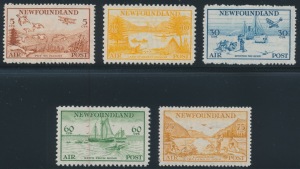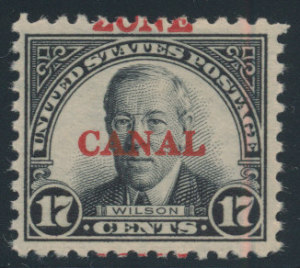By 1975, Henry Harris was an old man and was ready to
Monthly Archives: December 2013
- Posted December 30, 2013Read more »
- Posted December 27, 2013Read more »Bill Evans was already an avid collector when he started coming to our auctions some thirty years ago. He was of Hungarian descent and gravitated towards Hungarian philately. He became particularly interested in a specialized area of Hungarian philately called Hungarian Occupations
- Posted December 25, 2013Read more »Dave and Jenny were older when I first met them in the early 1970s. My first job at the company was working in the shop (we had one then), and Dave and Jenny were regulars. They had married late, and because of the economic distress of the Depression had put off children until that wasn't a possibility anymore. Like many older, childless couples, they grew closer and even parental and protective towards each other, and I thought they had one of the fondest relationships I had ever seen. They did everything together
- Posted December 23, 2013Read more »There is nothing more exciting for a collector than to complete a collection of stamps, and Kionga makes it about as easy as it gets. There were only four stamps issued in the entire history of the country, and they sell for about $50. Kionga is a tiny scrap of real estate on the east coast of Africa between the German colony of East Africa and the British colony of Tanzania. In the scramble for Africa, Portugal got a slice of this area as Portuguese East Africa and then later in 1916 issued stamps there under the country name of Kionga which was the town of some 4,000 people that existed there.Of all the European Colonial possessions, the Portuguese and the Spanish maintained some of the dodgiest. They often set up little claims near larger commercial claims of Great Britain, France, and Germany hoping to gain some long term benefit but often really doing no more than issuing postage stamps. The Spanish
- Posted December 20, 2013Read more »Many collectors spend a great deal of money on their hobby and don't have a great deal to show for it. Your money is yours to do with as you please (after all, this is America), but most people take some satisfaction in getting their money's worth when they buy something and, if not always getting the best of all possible deals, at least getting product commensurate with what they have spent. If you wish to do that, stay away from estate sales. Many of the worst collections and stocks that I have ever seen have been put together at estate sales
- Posted December 18, 2013Read more »The value of most United States stamps have been falling over the last twenty years, and the CPI has been rising. Critics have claimed that the CPI overemphasizes increases in food, fuel, and housing (until the last few years, at least). We have not understood that price increases have been commodity driven and that many existing goods and non-commodity goods have remained stable in price or even declined, just as stamps have. I refer, of course, to the economic metric known as the "Lawn Blower Index" (the "LBI"), a personal index of prices and inflation which I compiled yesterday. Specifically, it was time to blow some leaves and clean out my garage yesterday, and my gas powered leaf blower was broken. About twenty years ago, I bought this low end gas blower for $149. Home Depot had one yesterday at $99, and it is about ten times easier to use, lighter, and blows more leaves per gallon.
- Posted December 16, 2013Read more »The story of philately over the last twenty years is the story of the Internet and of eBay. It's hard to quantify eBay's philatelic success (as they keep their numbers for each of their divisions to themselves), but it's clear they offer millions of lots per year to hundreds of thousands of buyers on behalf of tens of thousands of sellers. eBay probably sells more dollar volume worth of stamps than all of the other stamp auctioneers and websites combined. eBay has lowered the barriers to entry for all new sellers. In the previous generation, companies like Apfelbaum, with our large mailing list and years of customer satisfaction, had the stamp auction business locked up. New companies had a very difficult time finding material to sell, finding good customers to sell to, and having a clientele who could rely on them.eBay was wise to put its emphasis on customer
- Posted December 13, 2013Read more »The reason you should buy your stamps from Apfelbaum is not our prices (which are very attractive) or our service and shipping (which is not only free, but is also the fastest). You should buy your stamps from Apfelbaum because we are the only stamp company that assures your complete satisfaction and safety to this degree: buy any stamp or lot, and you may return it for any reason within thirty days for a full refund. Further, we guarantee every stamp we sell as being genuine and as described without time limit. This means if you buy a stamp from us and it ever turns out not to be genuine or if it has an undescribed fault, we will take it back for a full refund at any time in the future, even years later.
We ship virtually every order within 48 hours, answer all emails within hours (actually usually within minutes), and immediately refund on any returns. Our descriptions and evaluations of the stamps we sell are clear, accurate, and - Posted December 11, 2013Read more »The stamps of Newfoundland have always been a favorite with philatelists. The internal demand in Newfoundland itself is small because the population of that province is small, but the philately of Newfoundland is interesting and has always attracted Canadian collectors, British Commonwealth collectors, and US collectors. The stamps are interesting and well engraved. The first issues are very scarce and have some of the rarest stamps in philately, although listing major catalog numbers based solely on paper and shade differences has always seemed silly to me. Stamps printed from the same plates and of the same denomination and color should generally be the same major catalog number, and varieties of paper and shade should be minor "a" numbers. This is not the case with the first issues of Newfoundland, and collectors do not readily take to these stamps. The twentieth century issues are very well engraved and tastefully designed and have always been avidly collected.
- Posted December 09, 2013Read more »Women and men probably collect things about equally. Women, however, just don't collect stamps. Philately has long been a man's domain. After the passing of the "timbremania" phase about 1860, the vast majority of stamp collectors, and certainly the vast majority of more serious philatelists, have been men. Of the hundreds of early philatelic books and articles that I've read, only a few have been penned by women. Of the people who have listed themselves as "followers" of this blog, all are men. And the APS membership is 90% male. I can't think of any serious articles about stamps written by women before 1960. Even the greatest female collector of the last century, Louise Boyd Dale, was carrying on the great collection of her father Alfred Liechtenstein.There are three main reasons for the lesser appeal of philately to women. First, there is a male
- Posted December 06, 2013Read more »Thematic stamp collecting along conceptual lines has never really caught hold. There was a great gold medal collection making the rounds of the APS Champion of Champions shows several years ago entitled "Murder" where the collector sought to portray how murder was shown on stamps from individual murderers to genocide (such as the Holocaust). But few other thematic collections have tried the "concept" route, and today we are mostly stuck with thematics such as Birds on Stamps or Disney which really only use stamps as pictures in a scrapbook to illustrate the collection's thematic point. From a historian's or social scientist's perspective, a good thematic collection could be far more satisfying than traditional philately. Research opportunities in most mainstream philatelic areas have either been done many times or else are relegated to the extreme fringes of postal history or plate varieties. Many subjects have never been collected philatelically and offer wonderful opportunities for collectors.
- Posted December 04, 2013Read more »Of the major worldwide powers in the philately era (that is, since 1840), the least imperialistic has been the United States. Great Britain and France had between them hundreds of imperial philatelic entities. Germany was a big player, and even Italy, which had more of an appetite for conquest than the digestion, had fifty or more imperial philatelic areas for which she issued stamps. Partly because our own internal markets were so large, partly because of immigration, partly because of endless land to be developed, and maybe a bit because of our democratic aspirations, America was a far smaller player in the Imperial game than our European competitors.This changed a bit in the late Nineteenth Century when the Spanish American war gave America three colonies
- Posted December 02, 2013Read more »One of the most remarkable economic trends of the last several years has been the beginnings of economic growth in sub-Saharan Africa. Worldwide last year, seven of the twenty countries with the highest GDP growth rates were in sub-Saharan Africa, and only Nigeria could claim that the reason that they were in this group was because of natural resources or oil. Admittedly the growth in Africa is coming from a very depressed level, and several years of even stellar growth for these countries does not put them in the realm of places most of us would like to live. But still, growth is growth, and it wasn't too long ago that most economists felt that Africa would never be growing at rates that could advance the living standards of its people. Certainly we can't count on such growth continuing. But as wages grow in many other third world countries, business should flock to the lowest wage countries, and, if the African work force is good, industry will










